flat tire TOYOTA COROLLA HATCHBACK 2020 Warranties & Maintenance Guides (in English)
[x] Cancel search | Manufacturer: TOYOTA, Model Year: 2020, Model line: COROLLA HATCHBACK, Model: TOYOTA COROLLA HATCHBACK 2020Pages: 260, PDF Size: 8.54 MB
Page 154 of 260
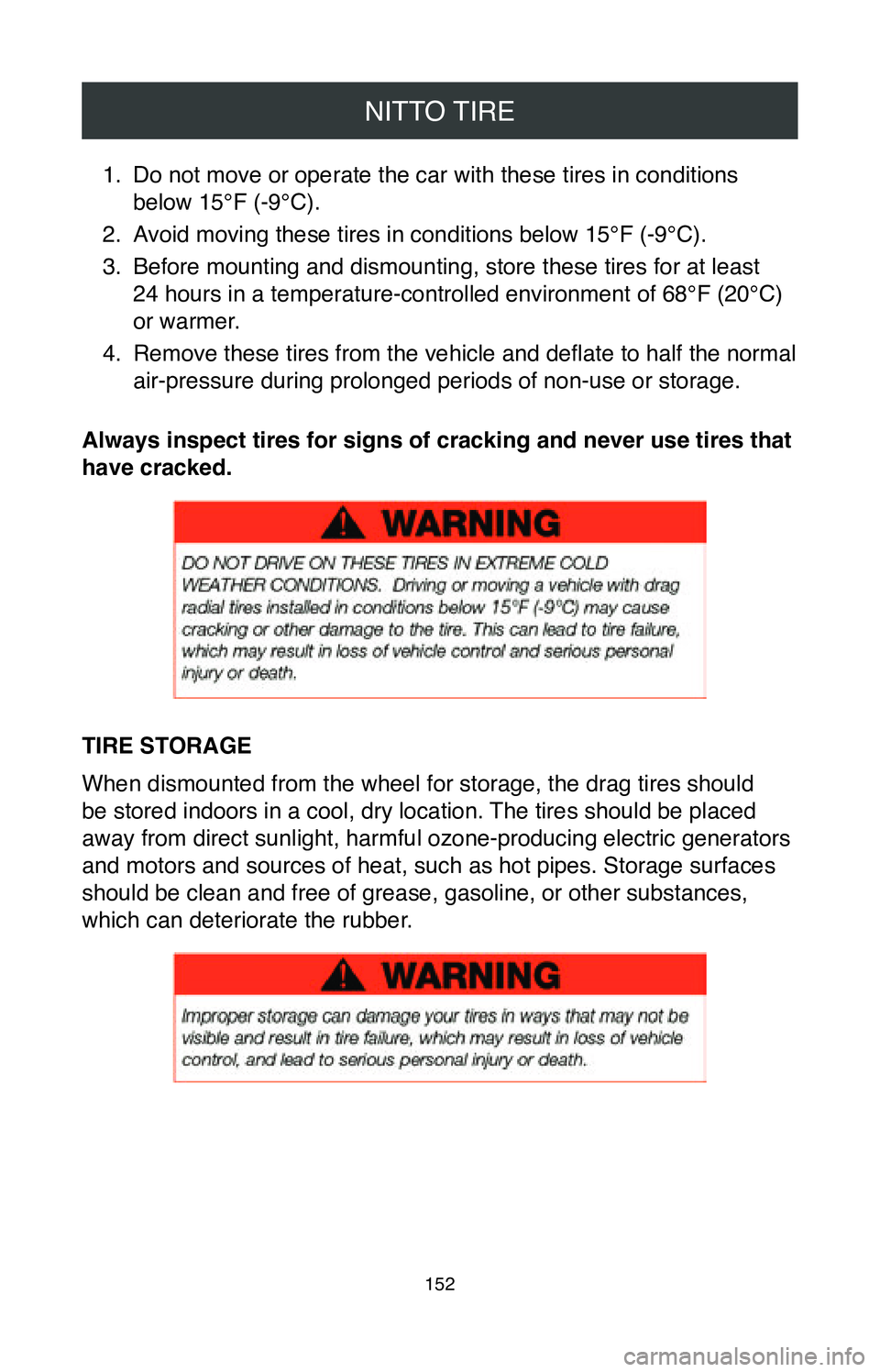
NITTO TIRE
152
1. Do not move or operate the car with these tires in conditions
below 15°F (-9°C).
2.
Avoid moving these tires in conditions below 15°F (-9°C).
3.
Before mounting and dismounting, store these tires for at least
24 hours in a temperature-controlled environment of 68°F (20°C)
or warmer.
4.
Remove these tires from the vehicle and deflate to half the normal
air-pressure during prolonged periods of non-use or storage.
Always inspect tires for signs of cracking and never use tires that
have cracked.
TIRE STORAGE
When dismounted from the wheel for storage, the drag tires should
be stored indoors in a cool, dry location. The tires should be placed
away from direct sunlight, harmful ozone-producing electric generators
and motors and sources of heat, such as hot pipes. Storage surfaces
should be clean and free of grease, gasoline, or other substances,
which can deteriorate the rubber.
Page 155 of 260
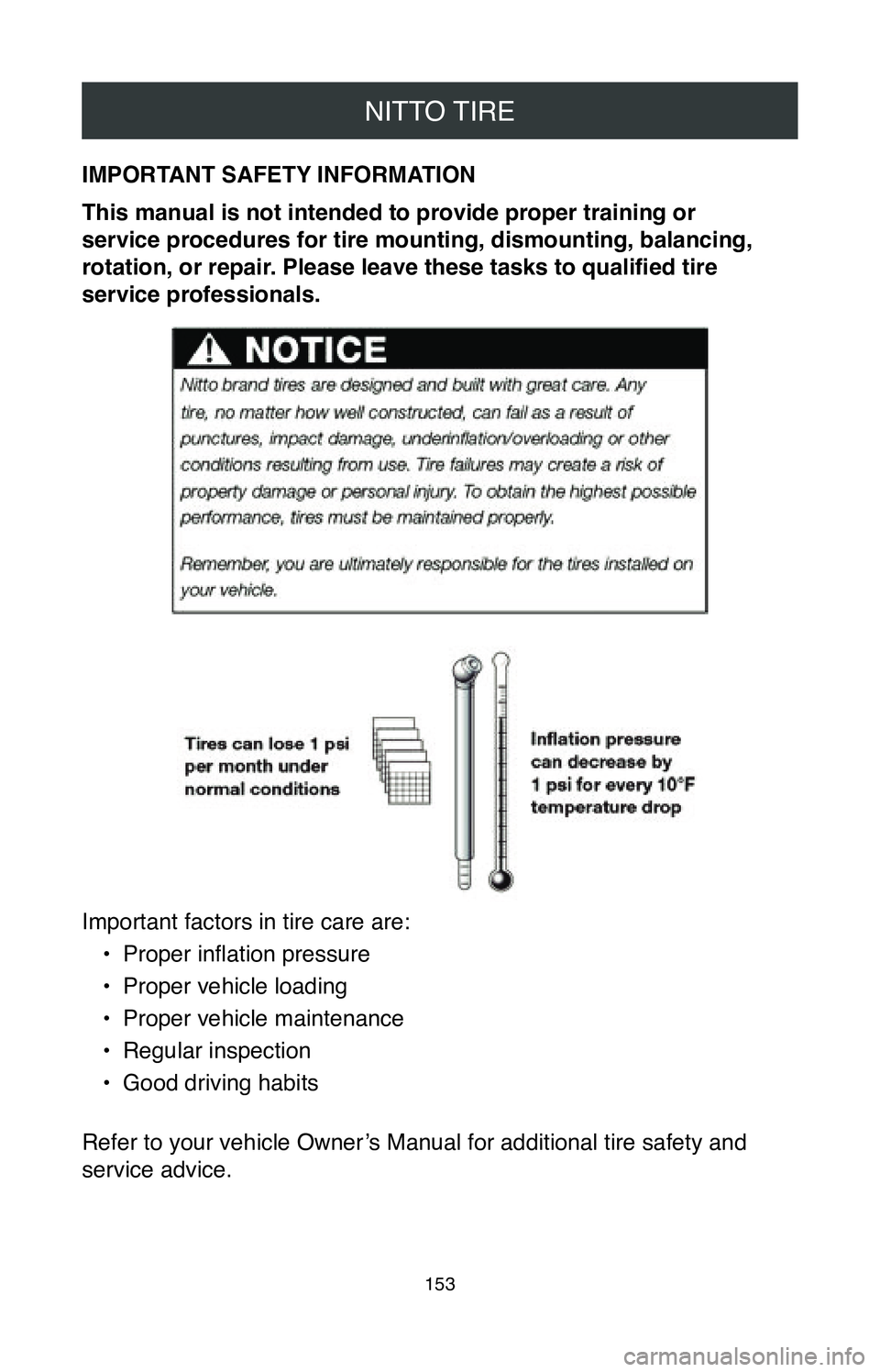
NITTO TIRE
153
IMPORTANT SAFETY INFORMATION
This manual is not intended to provide proper training or
service procedures for tire mounting, dismounting, balancing,
rotation, or repair. Please leave these tasks to qualified tire
service professionals.
Important factors in tire care are:•
Proper inflation pressure
•
Proper vehicle loading
•
Proper vehicle maintenance
•
Regular inspection
•
Good driving habits
Refer to your vehicle Owner’s Manual for additional tire safety and
service advice.
Page 156 of 260
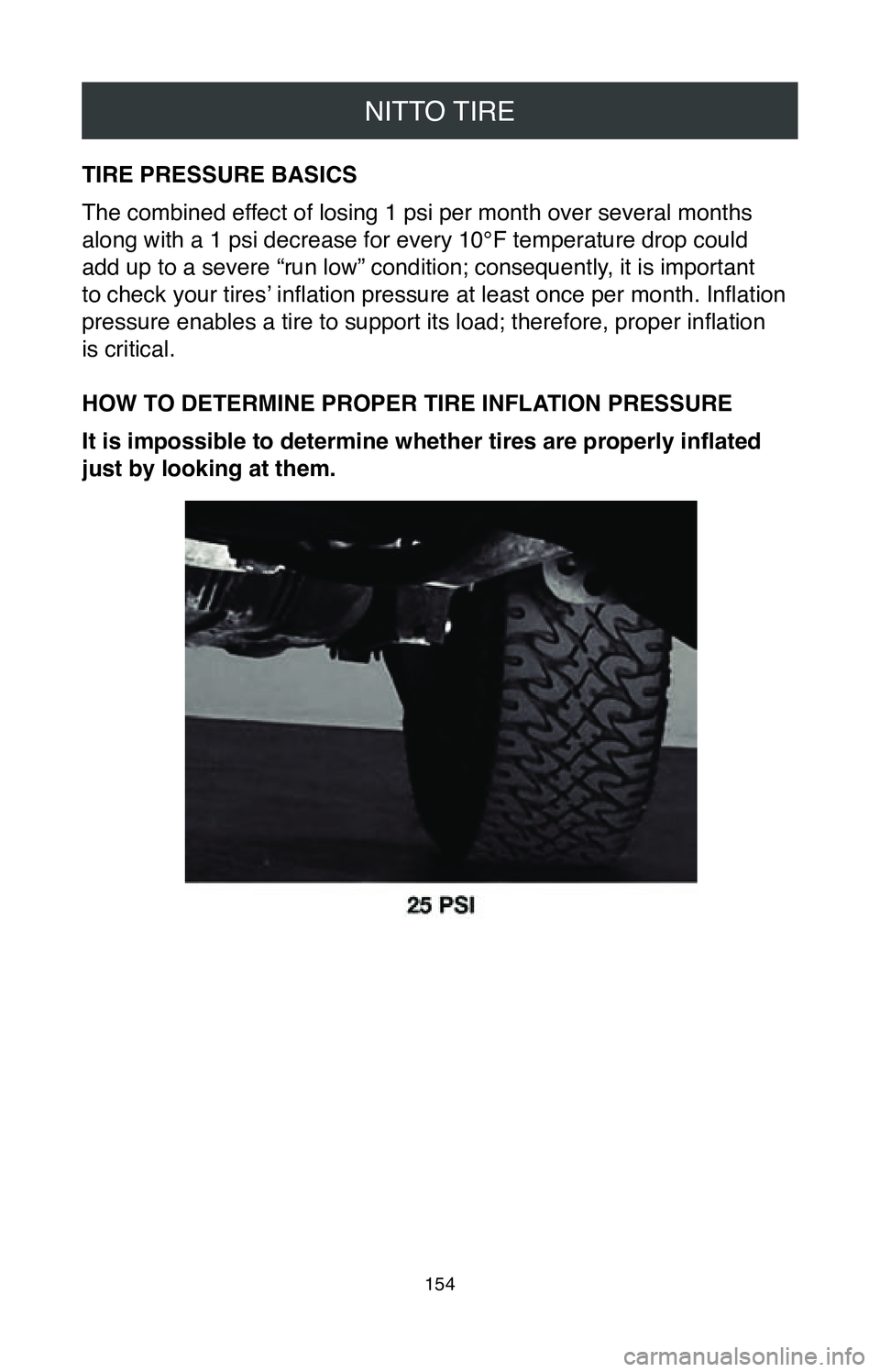
NITTO TIRE
154
TIRE PRESSURE BASICS
The combined effect of losing 1 psi per month over several months
along with a 1 psi decrease for every 10°F temperature drop could
add up to a severe “run low” condition; consequently, it is important
to check your tires’ inflation pressure at least once per month. Inflation
pressure enables a tire to support its load; therefore, proper inflation
is critical.
HOW TO DETERMINE PROPER TIRE INFLATION PRESSURE
It is impossible to determine whether tires are properly inflated
just by looking at them.
Page 158 of 260
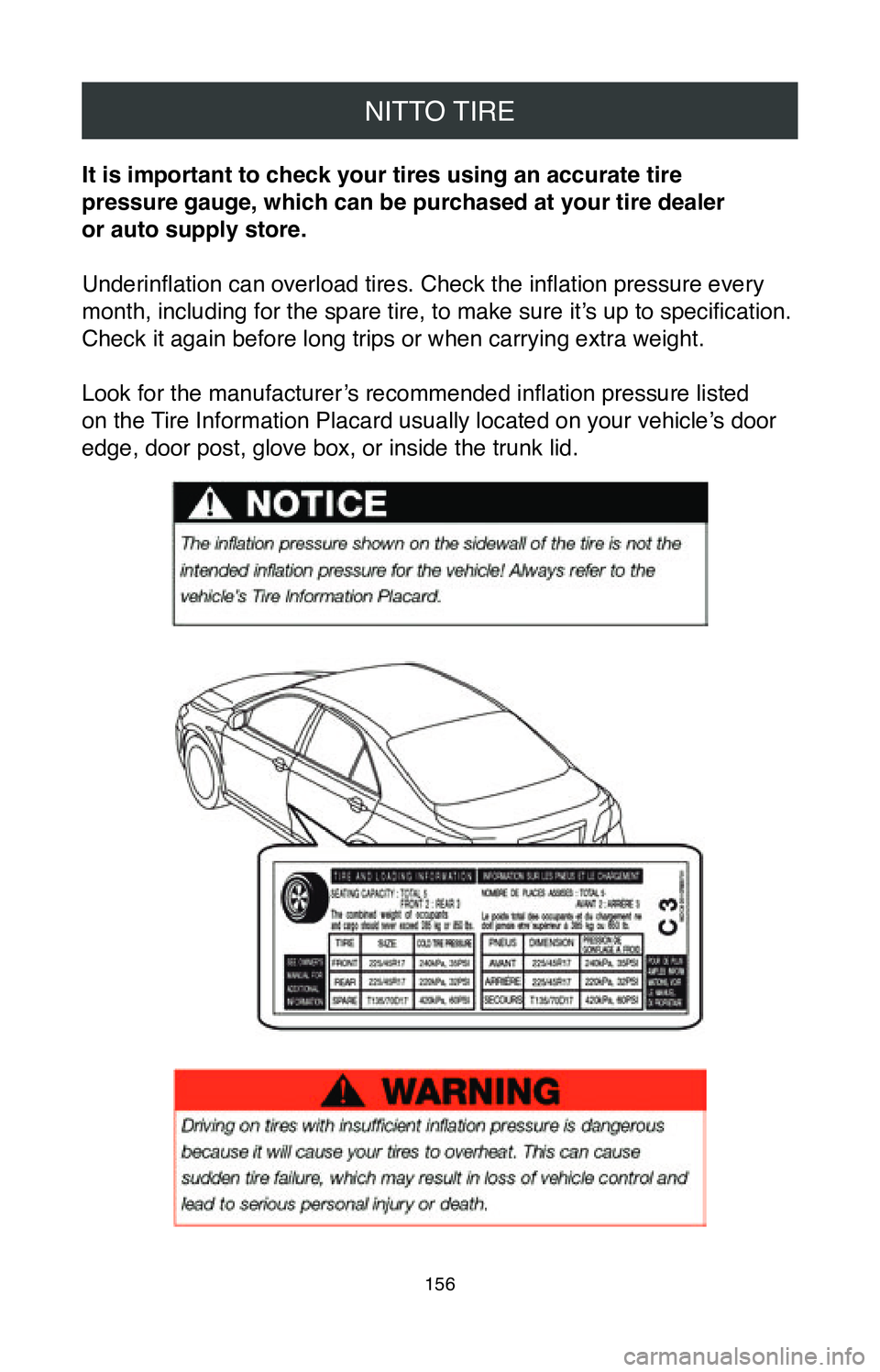
NITTO TIRE
156
It is important to check your tires using an accurate tire
pressure gauge, which can be purchased at your tire dealer
or auto supply store.
Underinflation can overload tires. Check the inflation pressure every
month, including for the spare tire, to make sure it’s up to specification.
Check it again before long trips or when carrying extra weight.
Look for the manufacturer’s recommended inflation pressure listed
on the Tire Information Placard usually located on your vehicle’s door
edge, door post, glove box, or inside the trunk lid.
Page 159 of 260

NITTO TIRE
157
USING A TIRE PRESSURE GAUGE
For accuracy, check your inflation pressure with a tire pressure gauge
when tires are cold (for example, after being parked overnight). Driving
heats up tires and causes an inaccurate pressure reading.
To check inflation pressure with a tire pressure gauge:1.
Remove the tire valve cap.
2.
Place the end of the tire pressure gauge over the valve.
3.
Press the tire pressure gauge straight and firmly and take
a reading.
4.
If needed, inflate and recheck the pressure with the tire
pressure gauge.
5.
Replace the valve cap.
RECOMMENDATIONS FOR SAFE TIRE INFLATION •
If you must inflate your tires when they are hot, add 4 pounds per
square inch (4 psi) (28 kPa) above the recommended inflation
pressure specification. Recheck the inflation pressure when the
tires are cold and adjust to the recommended inflation pressure
shown on the vehicle’s Tire Information Placard.
•
Never release air or nitrogen from a hot tire in order to reach
the recommended cold tire pressure. Normal driving causes
tires to run hotter and inflation pressure to increase. If you
release pressure when your tires are hot, you may dangerously
underinflate your tires. If your tires lose more than 1 pound
per square inch (1 psi) per month, the tire, the valve, or the
wheel may be damaged. Consult your authorized Nitto dealer for
an inspection.
Page 160 of 260
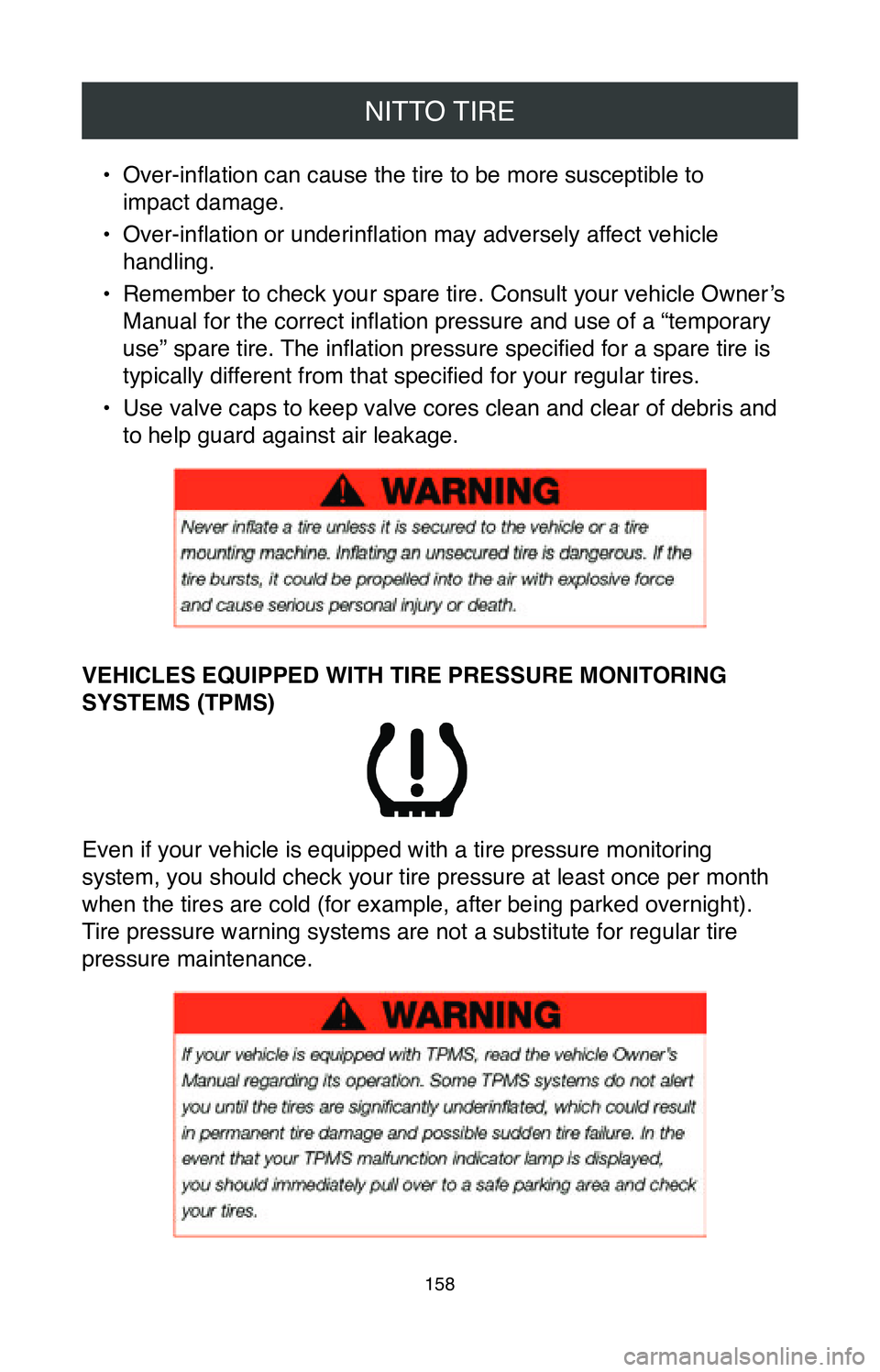
NITTO TIRE
158
• Over-inflation can cause the tire to be more susceptible to
impact damage.
•
Over-inflation or underinflation may adversely affect vehicle
handling.
•
Remember to check your spare tire. Consult your vehicle Owner’s
Manual for the correct inflation pressure and use of a “temporary
use” spare tire. The inflation pressure specified for a spare tire is
typically different from that specified for your regular tires.
•
Use valve caps to keep valve cores clean and clear of debris and
to help guard against air leakage.
VEHICLES EQUIPPED WITH TIRE PRESSURE MONITORING
SYSTEMS (TPMS)
Even if your vehicle is equipped with a tire pressure monitoring
system, you should check your tire pressure at least once per month
when the tires are cold (for example, after being parked overnight).
Tire pressure warning systems are not a substitute for regular tire
pressure maintenance.
Page 161 of 260
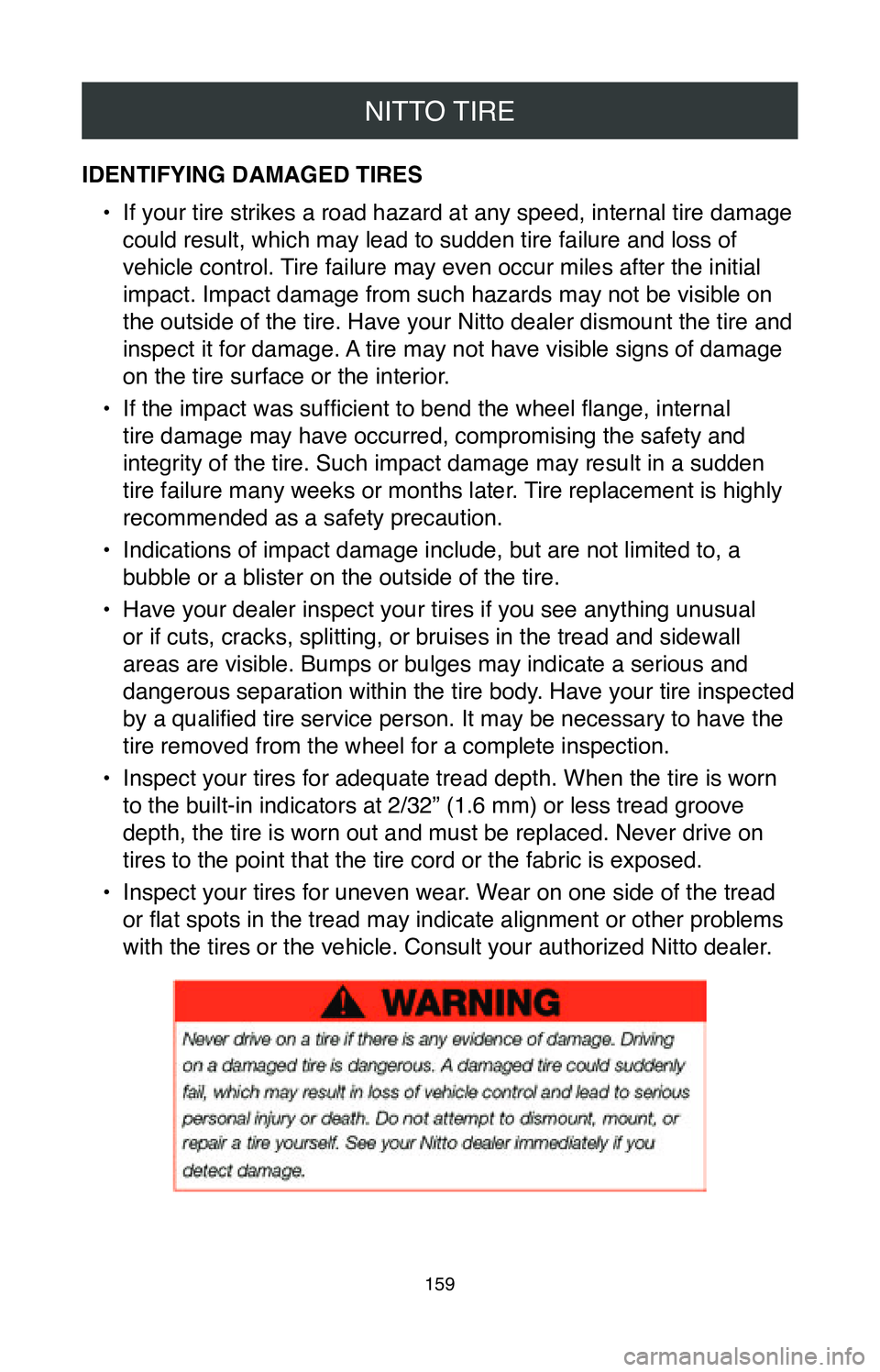
NITTO TIRE
159
IDENTIFYING DAMAGED TIRES•
If your tire strikes a road hazard at any speed, internal tire damage
could result, which may lead to sudden tire failure and loss of
vehicle control. Tire failure may even occur miles after the initial
impact. Impact damage from such hazards may not be visible on
the outside of the tire. Have your Nitto dealer dismount the tire and
inspect it for damage. A tire may not have visible signs of damage
on the tire surface or the interior.
•
If the impact was sufficient to bend the wheel flange, internal
tire damage may have occurred, compromising the safety and
integrity of the tire. Such impact damage may result in a sudden
tire failure many weeks or months later. Tire replacement is highly
recommended as a safety precaution.
•
Indications of impact damage include, but are not limited to, a
bubble or a blister on the outside of the tire.
•
Have your dealer inspect your tires if you see anything unusual
or if cuts, cracks, splitting, or bruises in the tread and sidewall
areas are visible. Bumps or bulges may indicate a serious and
dangerous separation within the tire body. Have your tire inspected
by a qualified tire service person. It may be necessary to have the
tire removed from the wheel for a complete inspection.
•
Inspect your tires for adequate tread depth. When the tire is worn
to the built-in indicators at 2/32” (1.6 mm) or less tread groove
depth, the tire is worn out and must be replaced. Never drive on
tires to the point that the tire cord or the fabric is exposed.
•
Inspect your tires for uneven wear. Wear on one side of the tread
or flat spots in the tread may indicate alignment or other problems
with the tires or the vehicle. Consult your authorized Nitto dealer.
Page 165 of 260

NITTO TIRE
163
Replacement tires for any vehicle must be of a size, load range, and
load capacity (by inflation) that is capable of supporting the same load
as the vehicle’s originally installed (OE) tires. Avoid installing used tires
on a vehicle. There is no way to determine what road hazards or abuse
a previously owned tire may have incurred.
The following procedures concerning replacement tires must
be followed:•
Confirm that the load-carrying capacity is greater than or equal
to the load-carrying capacity of the OE tire size at the pressure
indicated on the vehicle Tire Information Placard.
•
Carefully note any differences between recommendations for
front and rear axle positions regarding the tire size and/or
inflation pressure.
•
The speed rating must be equal to or greater than what is specified
by the vehicle manufacturer if the speed capability of the vehicle is
to be maintained.
•
Tires should be mounted on approved wheel widths. If changing
tire sizes, check to make sure the wheel has adequate load and
inflation pressure capacity.
•
Body and chassis clearance must be checked on the vehicle’s
front and rear axles.
In addition to the above, light truck tire replacements should take
into consideration the following:
Page 173 of 260

NITTO TIRE
171
Full-size spare tires (not temporary spares) of the same size,
construction, and speed rating may be used in a five-tire
rotation pattern.
After rotation, check the inflation pressure of all the tires. The front
and rear tire pressures may vary according to the vehicle
manufacturer’s specifications.
Remember to follow your vehicle Owner’s Manual for tire rotation
intervals. Your Limited Warranty recommends Nitto brand tires to be
rotated as follows:
•
Every 3,500 miles or less for high performance (low profile) tires.
•
Every 7,500 miles or less for standard passenger and light
truck tires.
More frequent rotation or a thorough vehicle inspection may be
necessary if, upon inspection, irregular or erratic treadwear is
beginning to appear.
It is important to remember the following: •
These tire rotation recommendations do not take into account
different tire and construction types mixed on the vehicle.
•
Some tires cannot be rotated in the manner described. Such tires
include unidirectional tires. Unidirectional tread patterns must be
rotated front-to-rear only so that the direction of revolution does
not change.
•
Some vehicles are designed with different tire sizes on the front
and rear axles. Normally, such combinations will not allow rotation.
Prior to rotating, consult the vehicle Owner’s Manual.
•
For vehicles with dual rear wheels, see the vehicle Owner’s
Manual for the vehicle manufacturer’s procedures. If your vehicle
Owner’s Manual is not available, please contact the vehicle
manufacturer.
•
Some vehicles are equipped with wheels that limit the choice of
rotation pattern. Consult the vehicle Owner’s Manual.
•
Do not include temporary spare tires in the rotation pattern.
However, if your spare tire is the same size and type as a road tire
(for LT tires of the same size, type, and load rating), it should be
Page 174 of 260
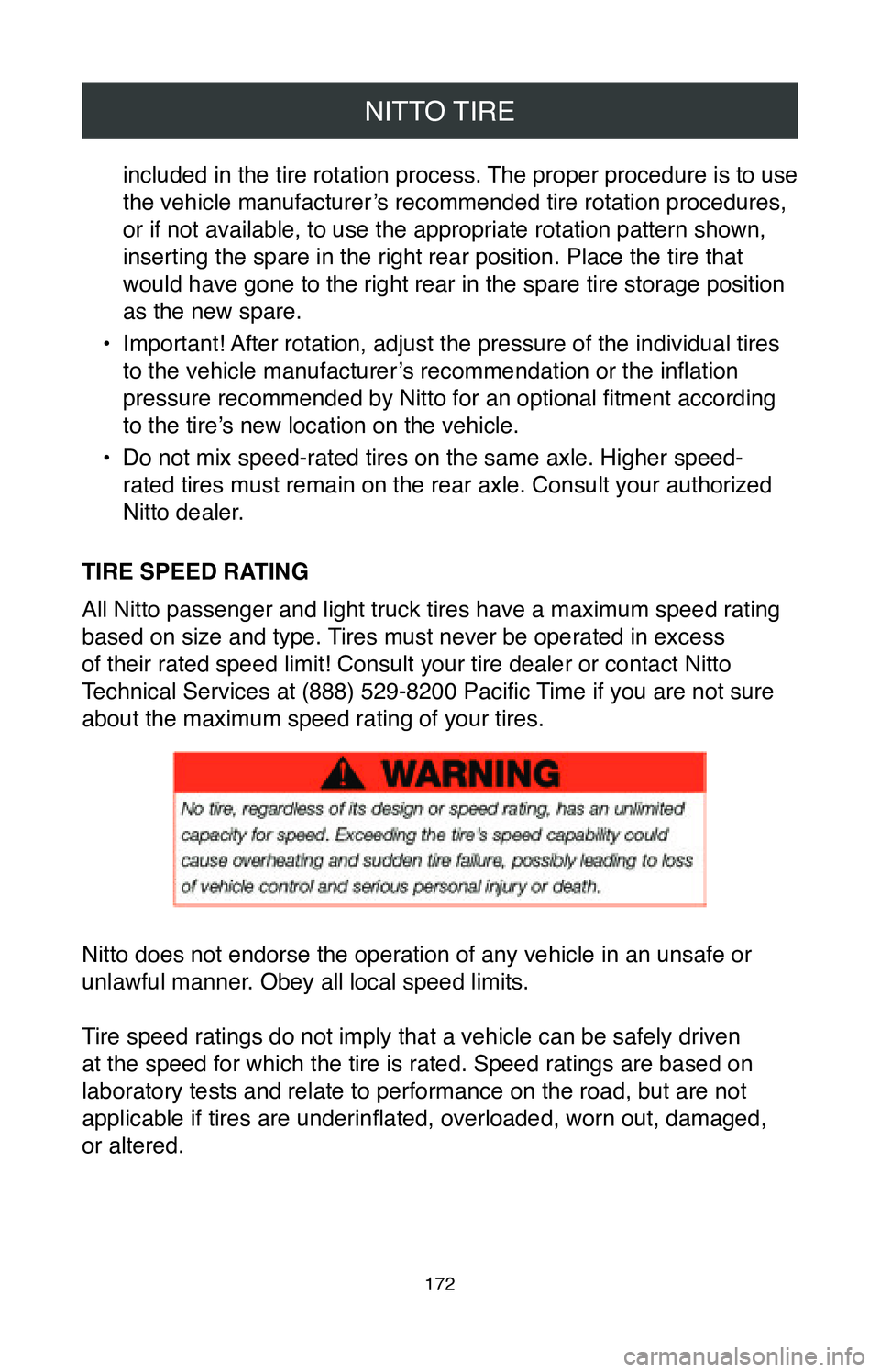
NITTO TIRE
172
included in the tire rotation process. The proper procedure is to use
the vehicle manufacturer’s recommended tire rotation procedures,
or if not available, to use the appropriate rotation pattern shown,
inserting the spare in the right rear position. Place the tire that
would have gone to the right rear in the spare tire storage position
as the new spare.
•
Important! After rotation, adjust the pressure of the individual tires
to the vehicle manufacturer’s recommendation or the inflation
pressure recommended by Nitto for an optional fitment according
to the tire’s new location on the vehicle.
•
Do not mix speed-rated tires on the same axle. Higher speed-
rated tires must remain on the rear axle. Consult your authorized
Nitto dealer.
TIRE SPEED RATING
All Nitto passenger and light truck tires have a maximum speed rating
based on size and type. Tires must never be operated in excess
of their rated speed limit! Consult your tire dealer or contact Nitto
Technical Services at (888) 529-8200 Pacific Time if you are not sure
about the maximum speed rating of your tires.
Nitto does not endorse the operation of any vehicle in an unsafe or
unlawful manner. Obey all local speed limits.
Tire speed ratings do not imply that a vehicle can be safely driven
at the speed for which the tire is rated. Speed ratings are based on
laboratory tests and relate to performance on the road, but are not
applicable if tires are underinflated, overloaded, worn out, damaged,
or altered.